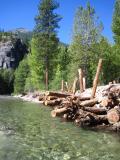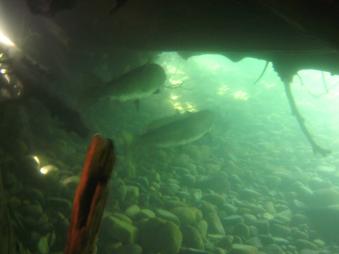This fish habitat enhancement project recreates habitat that is below historical and potential conditions. A total of 7 logjams were constructed in areas that would naturally accumulate wood, channel migration rates will be slowed while improving fish habitat. Large woody debris (LWD) was partially buried in adjacent banks and it extends out into the active channel. Buried vertical snags are associated with each logjam site to provide stability and increase wood recruitment. Dynamic adjustment to wood loading such as pool formation and bank scalloping around logjams is naturaland should be expected at all sites.
| Activity-High Level Habitat | ||
| Total Miles Of Instream Habitat Treated | 01 Miles | 8/10/2012 |
| Total Riparian Acres Treated | 09 Acres | 8/10/2012 |
| Total Riparian Miles Streambank Treated | 00.75 Miles | 8/10/2012 |
| Activity-Instream Habitat Project | ||
| Acres Of Channel/Off-Channel Connected Or Added | 09 Acres | 8/10/2012 |
| Miles of Off-Channel Stream Created | 00.75 Miles | 8/10/2012 |
| Miles of Stream Treated for channel reconfiguration and connectivity | 00.75 Miles | 8/10/2012 |
| Miles of Streambank Stabilized | 00.25 Miles | 8/10/2012 |
| Number of structures placed in channel | 07 Number | 8/10/2012 |
| Pools Created through channel structure placement | 07 Number | 8/10/2012 |
| Activity-Riparian Habitat Project | ||
| Acres Planted in riparian | 09 Acres |
8/10/2012 |
In addition to large wood placement, there are five locations where backwater or off-channel rearing habitats for juvenile salmonids was created. These types of habitats are located in existing natural backwater areas that can be enhanced by widening and lengthening to increase the total usable area during low flow stage and discharge. Imported wood will be used at each site for cover habitat.
There are two types of off-channel design based on how they will function with the river. The first type does not have water running through it, but behaves like a cutoff oxbow channel and fluctuates in wetland and habitat area based on the stage of the Entiat River. In this type of channel, the excavated segments will be free draining to prevent fish stranding as water levels drop in the summer. The backwater channel would extend its length and area as river stage rises. Large wood will be imported and vertical snags buried for cover habitat within enhanced backwater areas.
A second type of off-channel habitat is proposed in areas that could be associated with surface water running through constructed off-channel habitats. In these locations, more complex pool forms could be created. The pools will be maintained by surface water, reducing the risk of stranding and mortality as Entiat River flows reduce in the summer. These will be based on slope and possible groundwater availability. One particular site has the potential for a groundwater gallery to provide running water. Further survey, test pits and pump tests will have to be conducted during the summer (low water regime) to evaluate this site and determine if a groundwater gallery is feasible.
An additional site takes advantage of Brennegan Creek. At this site, an old Entiat River channel will be excavated to increase total habitat area, allowing Brennegan Creek to feed water through it to the mainstem. Created off-channel habitats will fill in with sediment over time as the Entiat River migrates throughout the valley and floodplain sediments accumulate. This is a natural process exhibited in all rivers. As some side channel habitats decay, others come into existence. The intent/strategy of this work is to create habitat that fish can use now to help make up the habitat deficit that has occurred following human disturbance. As large wood habitats are constructed and existing floodplain riparian forests age, the physical mechanisms will be in place for natural processes to create backwater and side channel habitats naturally via large trees falling into the river, mature meander bend development, and channel avulsions into mature forested valley bottom segments.
Project completed and goal were achieved.










